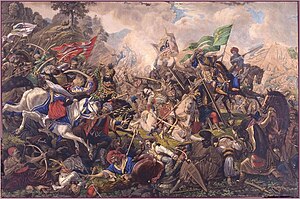This article needs additional citations for verification. (September 2016) |
| Battle of Breadfield | |||||||
|---|---|---|---|---|---|---|---|
| Part of the Ottoman–Hungarian Wars | |||||||
 Battle of Breadfield by Eduard Gurk | |||||||
| |||||||
| Belligerents | |||||||
| Ottoman Empire | |||||||
| Commanders and leaders | |||||||
|
Paul Kinizsi Stephen V Báthory Bartholomew Drágfi Vuk Grgurević-Branković Dmitar Jakšić Basarab Laiotă cel Bătrân | Ali Bey | ||||||
| Strength | |||||||
| 12,000–15,000 men (Hungarians, Székelys, Transylvanian Saxons, Serbs, Poles, Transylvanian Vlachs) |
Around 30,000 men consisting of Akıncı, Sipahi and Azaps, and some Janissary 1,000–2,000 Wallachian mercenaries[2] | ||||||
| Casualties and losses | |||||||
| 3,000 killed[citation needed] |
5,000–9,000 Ottomans killed 1,000 Wallachian[citation needed] | ||||||
The Battle of Breadfield (Hungarian: Kenyérmezei csata, German: Schlacht auf dem Brodfeld, Romanian: Bătălia de la Câmpul Pâinii, Turkish: Ekmek Otlak Savaşı) was the most tremendous conflict fought in Transylvania up to that time in the Ottoman–Hungarian Wars, taking place on October 13, 1479, on the Breadfield near the Saxon village of Alkenyér (also Zsibód, German: Unterbrodsdorf, Romanian: Șibot) next to the river Maros (Mureș). The Hungarian army was led by Pál Kinizsi, István Báthory, Vuk Branković, and Basarab Laiotă cel Bătrân.
The result of the battle was an important victory for the Kingdom of Hungary and the Serbian Despotate.
- '^ Battle of Breadfield (1479), Conflict and Conquest in the Islamic World: A Historical Encyclopedia, Vol. 1, ed. Alexander Mikaberidze, (ABC-CLIO, 2011), 215.
- ^ Kármán & Kunčevic 2013, p. 266.